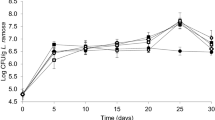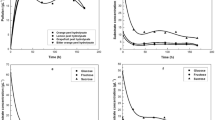Abstract
The bioconversion of jackfruit seed into a valuable product like Single-Cell Protein (SCP) was carried out using Generally Recognized As Safe (GRAS), five filamentous fungi such as Penicillium expansum, Aspergillus niger, Aspergillus oryzae, Rhizopus microsporus, and Candida intermedia by submerged fermentation. Data obtained from the study showed that supplementation of jackfruit seed extracts with inorganic nitrogen sources and glucose as a carbon source enhanced fungal biomass and SCP production. Among the various fungal strains, A. niger gave the highest biomass and protein yield of 4.01 ± 0.07 g/l and 1.82 ± 0.03 g/l, respectively, on the 9th day of fermentation followed by P. expansum (3.65 ± 0.04 g/l and 1.68 ± 0.03 g/l, respectively). C. intermedia growth was not recorded in all the experimental media. The present study revealed that fungal biomass has shown low crude fat, crude fiber, and total genomic DNA content ranged from 1.10 ± 0.20 to 4.95 ± 0.40%. A. niger and P. expansum were the most efficient in the conversion of sugar (55.83 ± 0.3% and 54.71 ± 0.4%, respectively) to yield biomass in sugar supplementation media. P. expansum and A. niger were the most promising fungal strains to produce fungal biomass protein using inexpensive agro-waste materials.


Similar content being viewed by others
Data Availability
The database generated during and/or analyzed during the current study are available from the corresponding author on reasonable request.
Code Availability
Not applicable.
References
Musa, M. A., Mada, S. B., Amin, M. I., Salihu, A., Garba, A., Mohammad, H. A., Nasidi, A., & Maccido, D. A. (2017). Effect of nutrient supplementation on single cell protein production from watermelon and pineapple peels. Nigerian Journal of Basic and Applied Sciences, 25(1), 130–136. https://doi.org/10.4314/njbas.v25i1.17
Siada, O. A. A., Negm, M. S., Basiouny, M. E., Fouad, M. A., & Elagroudy, S. (2017). Protein enrichment of agro–industrial waste by Trichoderma harzianum EMCC 540 though solid state fermentation for use as animal feed. Journal of Geography, Environment and Earth Science International, 13(4), 1–12. https://doi.org/10.9734/JGEESI/2017/39019
Yazid, N. A., Barrena, R., Komilis, D., & Sánchez, A. (2017). Solid-state fermentation as a novel paradigm for organic waste valorization: A review. Sustainability., 9(224), 1–28. https://doi.org/10.3390/su9020224
Oshoma, C. E., & Eguakun-Owie, S. O. (2018). Conversion of food waste to single cell protein using Aspergillus niger. Journal of Applied Sciences and Environmental Management, 22(3), 350–355. https://doi.org/10.4314/jasem.v22i3.10
Kalsoom, A., Shah, A. A., Ihsan, K., Khan, F. A., & Jamil, J. (2017). Nutritional assessment of single cell protein produced with Aspergillus flavus and Penicillium chrysogenum. International Journal of Biosciences, 11(5), 62–69.
Ahmed, S., Mustafa, G., Arshad, MD., & Rajoka, MD. I. (2017). Fungal biomass protein production from Trichoderma harzianum using rice polishing. BioMed Research International, 2017, 1–9. https://doi.org/10.1155/2017/6232793
Ukaegbu-OBI, K. M. (2016). SCP: A resort to global protein challenge and waste management. Journal of Microbiology & Microbial Technology, 1(1), 1–5.
Saheed, O. K., Jamal, P., Karim, M. I. A., Alam, M. D. Z., & Muyibi, S. A. (2016). Utilization of fruit peels as carbon source for white rot fungi biomass production under submerged state bioconversion. Journal of King Saud University - Science, 28, 143–151.
Shukla, N. G., Ghoradkar, A. S., & Gomashe, A. V. (2017). Comparative assessment of fruit waste as potential substrates for the production of single cell protein by Saccharomyces cerevisiae and Spirulina. International Journal of BioSciences, Agriculture and Technology, 5(2), 798–802.
Ahuja, S., & Kumari, P. (2019). Production of single cell protein from fruit and vegetable waste using Saccharomyces cerevisiae. International Journal of Current Microbiology and Applied Sciences, 8(2), 114–124.
Umesh, M., Thazeem, B., & Preethi, K. (2019). Valorization of pineapple peels through single cell protein production using Saccharomyces cerevisiae NCDC 364. Applications of Food Biotechnology, 6(4), 255–263.
Awad, A. S., Saad, S. M., Mekawi, E., & Attia, N. Y. (2021). Production of single-cell protein from some fruit peels. Annals of Agricultural Science, Moshtohor, 59(3), 755–762. https://doi.org/10.21608/assjm.2021.207308
Dunuweera, A. N., Nikagolla, D., N., & Ranganathan, K. (2021). Fruit waste substrates to produce single-cell proteins as alternative human food supplements and animal feeds using baker’s yeast (Saccharomyces cerevisiae). Journal of Food Quality, 2021, 1–6. https://doi.org/10.1155/2021/9932762
Anbu, S., Padma, J., Punithavalli, K., & Saranraj, P. (2017). Fruits peel waste as a novel media for the growth of economically important fungi. Journal of Pharmacognosy and Phytochemistry, 6(6), 426–428.
Abedin, M. S., Nuruddin, M. M., Ahmed, K. U., & Hossain, A. (2012). Nutritive compositions of locally available jackfruit seeds (Artocarpus heterophyllus) in Bangladesh. International Journal of Biosciences, 2(8), 1–7.
Islam, M. D. S., Begum, R., Khatun, M., & Dey, K. C. (2015). A study on nutritional and functional properties analysis of jackfruit seed flour and value addition to biscuits. International Journal of Engineering Research & Technology, 4(12), 139–147.
Sultana, A., Amin, M. D. N., Miah, M. D. Y., Sarker, A. K., Rasel, M. D. M. A., Aziz, M. D. T., Sharmin, F., Hakim, M. D. A., Shiddika, H., Emon, S. H., Tuli, T. P., & Khanom, M. M. (2017). Determination of proximate composition and amino acid profile of jackfruit seed and utilization of its seed flour for development of protein enriched supplementary food. Cell Biology, 5(6), 57–65.
Kates, M. (1972) Techniques of lipidology: Isolation, analysis and identification of lipids, 2nd rev. ed., North-Holland Pub. Co., Amsterdam.
Sadasivam, S. & Manickam, A. (1997). Biochemical methods. 2nd ed., New age International (p) Ltd. Publisher, New Delhi.
Hedge, J. E., & Hofreiter, B. T. (1962). Carbohydrate chemistry (17th ed.). Academic Press (New York).
Lowry, O. H., Rosebrough, N. J., Farr, A. L., & Randall, R. J. (1951). Protein measurement with the Folin phenol reagent. Journal of Biological Chemistry, 193(1), 265–275.
AOAC. (1995), Fruits and Fruit Products. I n: Official methods of analysis of AOAC international, agricultural chemicals; contaminants; drugs. Association of Official Analytical Chemists International, 16th ed., Vol. 1. Arlington, Virginia.
Pearson, D. (1981) Pearson’s chemical analysis of foods, 8th ed. Churchill Livingston, Edinburgh.
Hassett, J. D., Charniga, L., Bean, K., Oman, E. D., & Cohen, S. M. (1992). Response of Pseudomonas aeruginosa to pyocyanin: Mechanisms of resistance antioxidant defenses, and demonstration of manganese, co factored superoxide dismutase. Infection and Immunity, 60, 328–336.
Somda, M. K., Nikiema, M., Keita, I., Mogmenga, I., Kouhounde, S. H. S., Dabire, Y., Coulibaly, W. H., Taale, E., & Traore, A. S. (2018). Production of single cell protein (SCP) and essentials amino acids from Candida utilis FMJ12 by solid state fermentation using mango waste supplemented with nitrogen sources. African Journal of Biotechnology, 17(23), 716–723. https://doi.org/10.5897/AJB2017.16361
Haddish, K. (2015). Production of single cell protein from fruit of Beles (Opuntia Ficus-Indica L.) peels using Saccharomyces cerevisiae. Journal of Microbiology & Experimentation, 3(1), 1–4. https://doi.org/10.15406/jmen.2015.02.00073
Mondal, A. K., Sengupta, S., Bhattacharyya, D. K., & Bhowal, J. (2012). Utilization of fruit wastes in producing single cell protein. International Journal of Environmental Science and Technology, 1(5), 430–438.
Khan, M. Y., & Dahot, M. U. (2010). Effect of various agriculture wastes and pure sugars on the production of SCP by Penicillium Expansum. World Applied Sciences Journal, 8, 80–84.
Kalpana, C., & Rajakumari, M. (2015). Bioconversion of fruit and vegetables waste in to single cell protein. Multidisciplinary Research, 2(2), 476–481.
Azam, S., Khan, Z., Ahmad, B., Khan, I., & Ali, J. (2014). Production of single cell protein from orange peels using Aspergillus niger and Saccharomyces cerevisiae. Global Journal of Biotechnology and Biochemistry, 9(1), 14–18.
Dharumadurai, D., Lawanya, S., Saha, S., Thajuddin, N., & Panneerselvam, A. (2011). Production of single cell protein from pineapple waste using yeast. Innovative Romanian Food Biotechnology, 8, 26–32.
Kandari, V., & Gupta, S. (2012). Bioconversion of vegetable and fruit peel wastes in viable product. Journal of Microbiology and Biotechnology Research, 2(2), 308–312.
Acknowledgements
The authors are thankful to the MTCC, Chandigarh, for providing purified fungal culture. The authors are thankful to the Indian Institute of Engineering Science and Technology, Shibpur (formerly Bengal Engineering and Science University, Shibpur), West Bengal, India, for providing facilities for the completion of this research work.
Author information
Authors and Affiliations
Contributions
Ankita Chakraborty: Experiments, formal analysis, validation, and writing original draft.
Jayati Bhowal: Conceptualization, supervision, and writing–review and editing.
Corresponding author
Ethics declarations
Ethical Approval
Not applicable.
Consent to Participate
Not applicable.
Consent to Publish
Not applicable.
Competing Interest
The authors declare no competing interests.
Additional information
Publisher's Note
Springer Nature remains neutral with regard to jurisdictional claims in published maps and institutional affiliations.
Rights and permissions
About this article
Cite this article
Chakraborty, A., Bhowal, J. Bioconversion of Jackfruit Seed Waste to Fungal Biomass Protein by Submerged Fermentation. Appl Biochem Biotechnol 195, 2158–2171 (2023). https://doi.org/10.1007/s12010-022-04063-8
Accepted:
Published:
Issue Date:
DOI: https://doi.org/10.1007/s12010-022-04063-8




